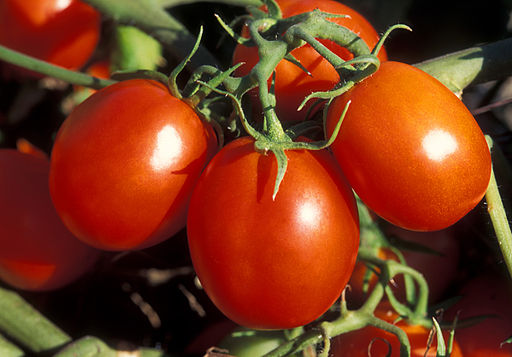Patent applications reveal ways to improve tomato production
Various inventions promising improved tomato production are covered in patent applications recently published by the US Patent and Trademark Office. In this small sample we look at a vine tomato that stays firm longer, tomatoes with higher sugar content, and greenhouse lighting helping insects find – and thus pollinate – flowers more easily.
Vine tomato with longer shelf life
California’s Arcadia Biosciences seeks a patent for “tomatoes that soften more slowly post-harvest due to non-transgenic alterations in an expansin gene.” In its patent application it explains new tomato varieties are needed that have the desirable qualities of vine-ripened fruit (in taste, texture and colour) but reduced spoilage. However it also notes some consumers don’t like genetically modified foods.
It says it has a solution with its (non–GMO) method, which is the product of a human-induced mutation in a tomato gene – LeExp1 – linked to fruit softening.
Tomatoes with higher sugar content
Tomatoes with improved fruit quality, such as increased levels of starch, soluble solids, and/or sugars are described in an application from the governing board (Regents) of the University of California. It says the ripe fruit has sugar levels (fructose and glucose) at least 10% higher, usually at least 30% higher, than control plants.
The method for which the patent is being sought involves producing plants that deliver green fruit with increased chloroplast development. This is achieved via a rise in what is known as GLK (Golden2-like) activity in the green fruit and results in an increase in the products of photosynthesis and carbon fixation, such as starch and eventually soluble sugars, in ripe fruit.
Putting flowers in their best light
And from Finland comes an application for an invention using special lighting in greenhouses to enhance insect pollination of plants, such as the tomato.
Valoya, a Helsinki-based provider of energy efficient LED lights, says the best effect is achieved when the emission peaks of the lighting have a high reflectivity from flowers and/or high sensitivity in the insect vision. “The insects can see the flowers better, and therefore find them more easily, which increases the efficiency of pollination by the insects.”
It says the method reduces insect mortality and increases pollination efficiency and photosynthetic growth, thereby improving the productivity of the plant cultivation.


